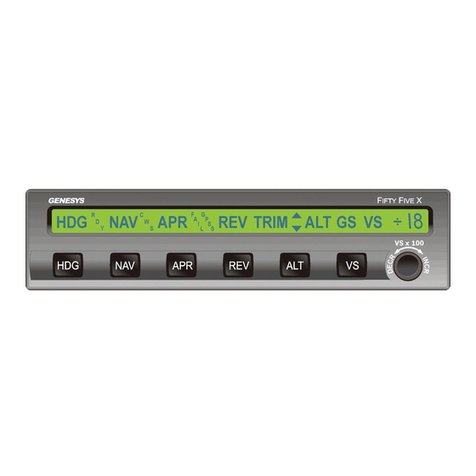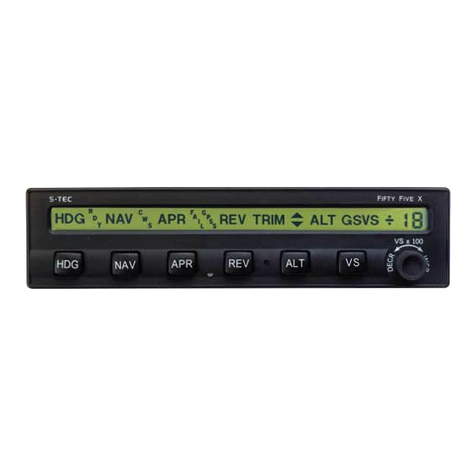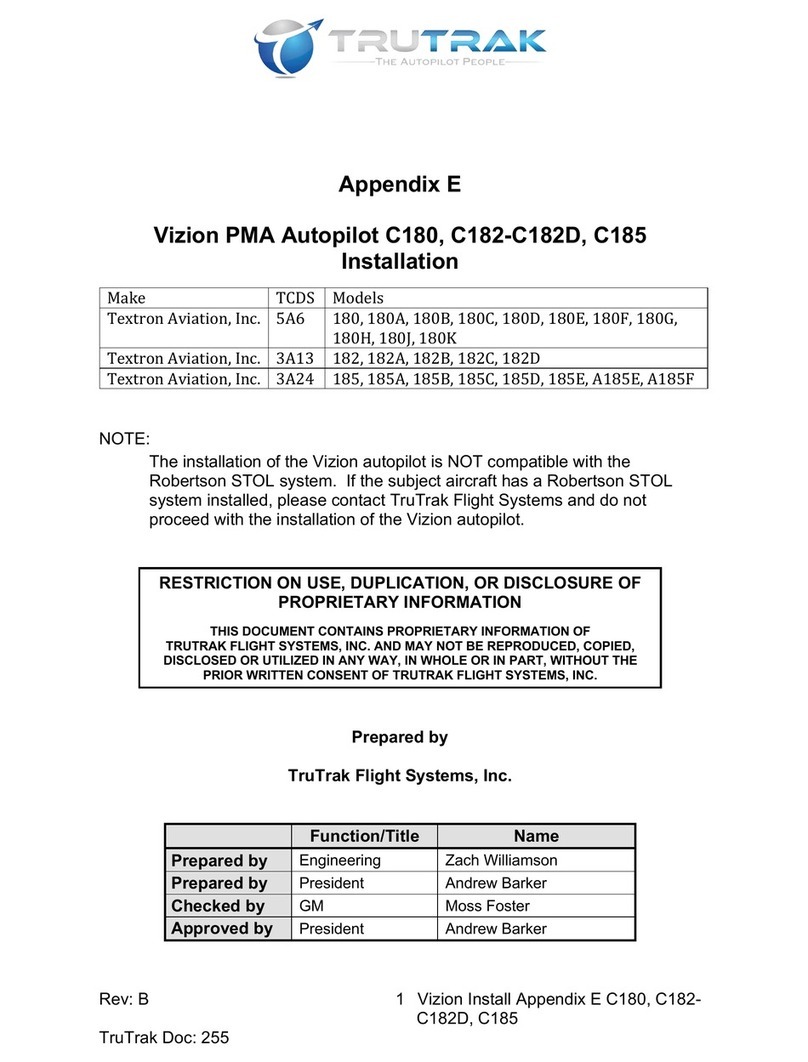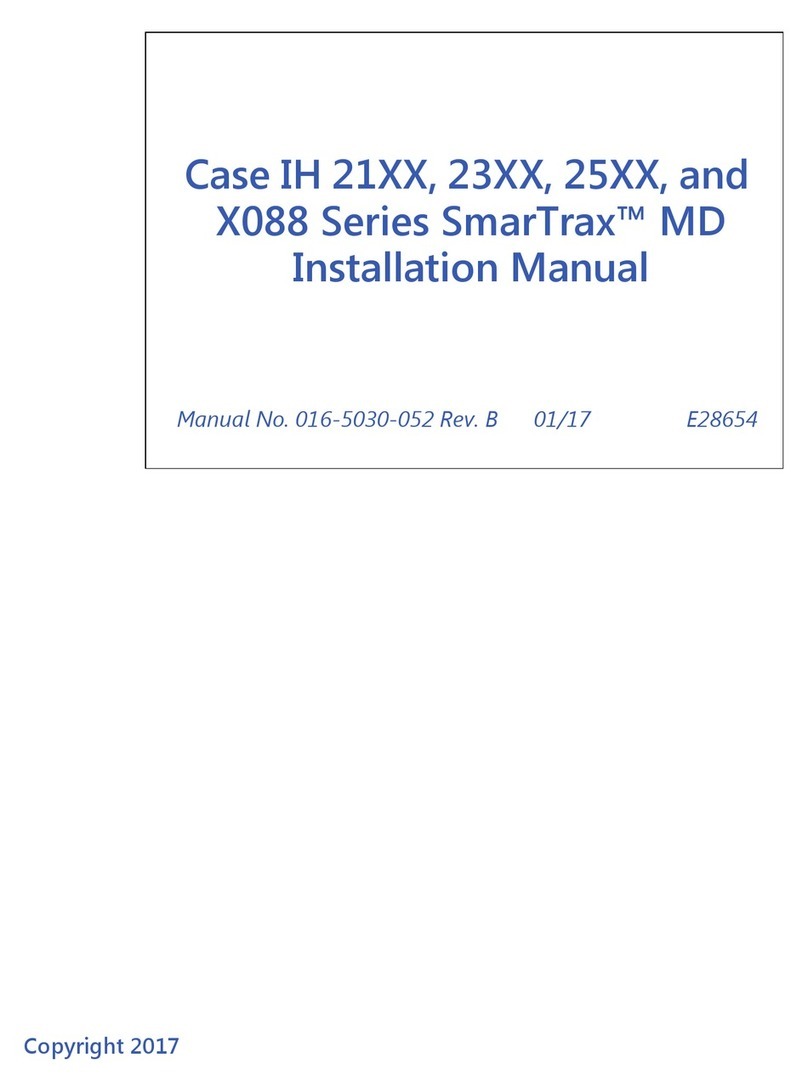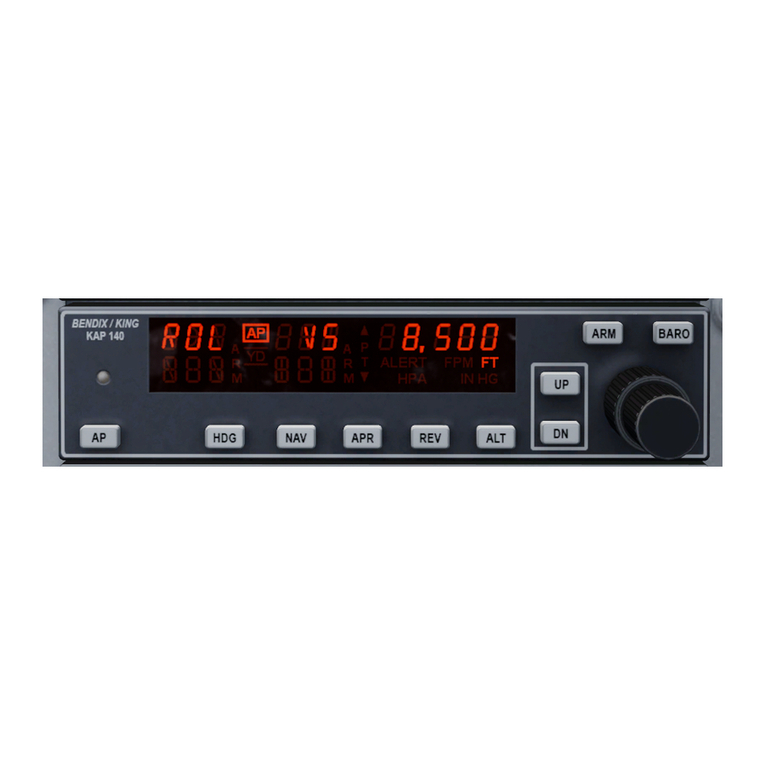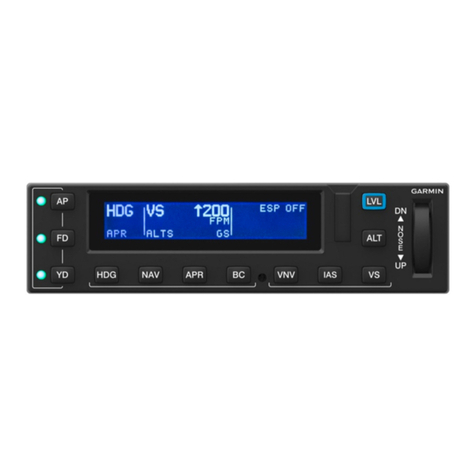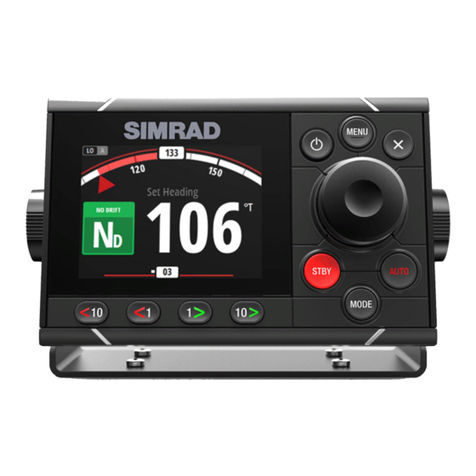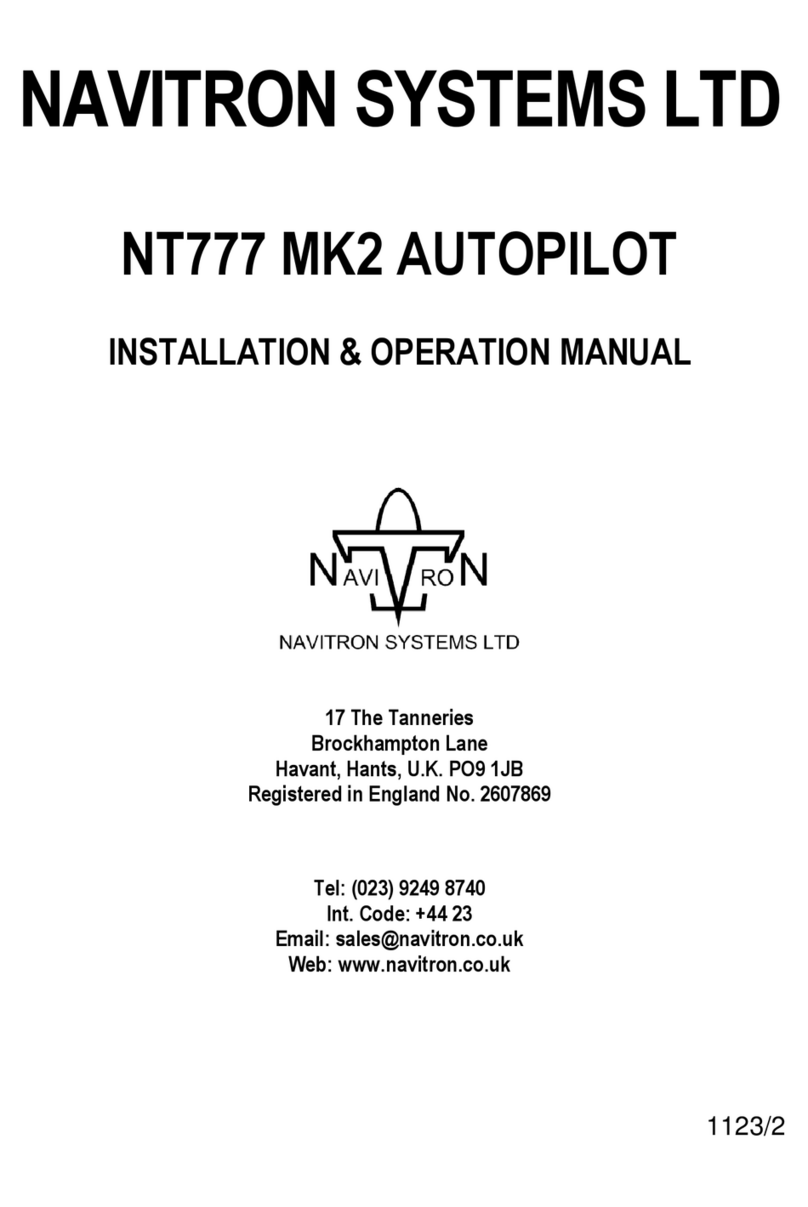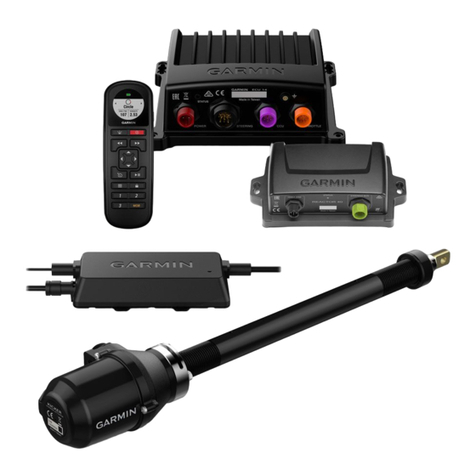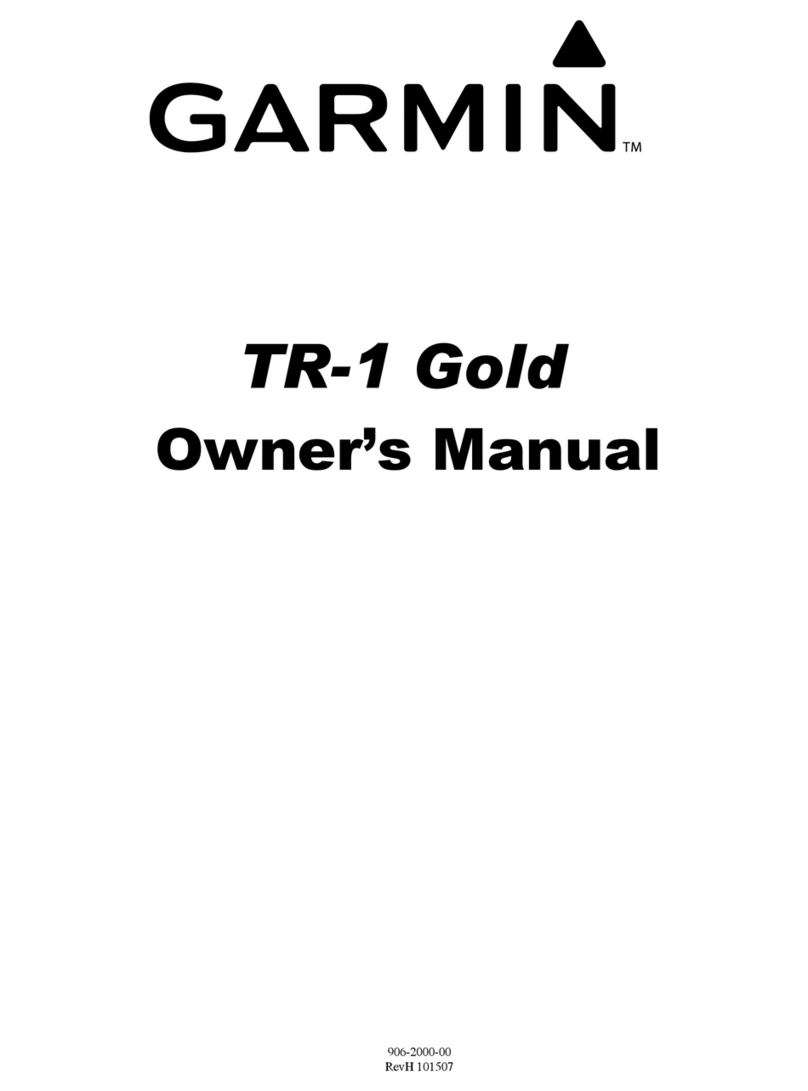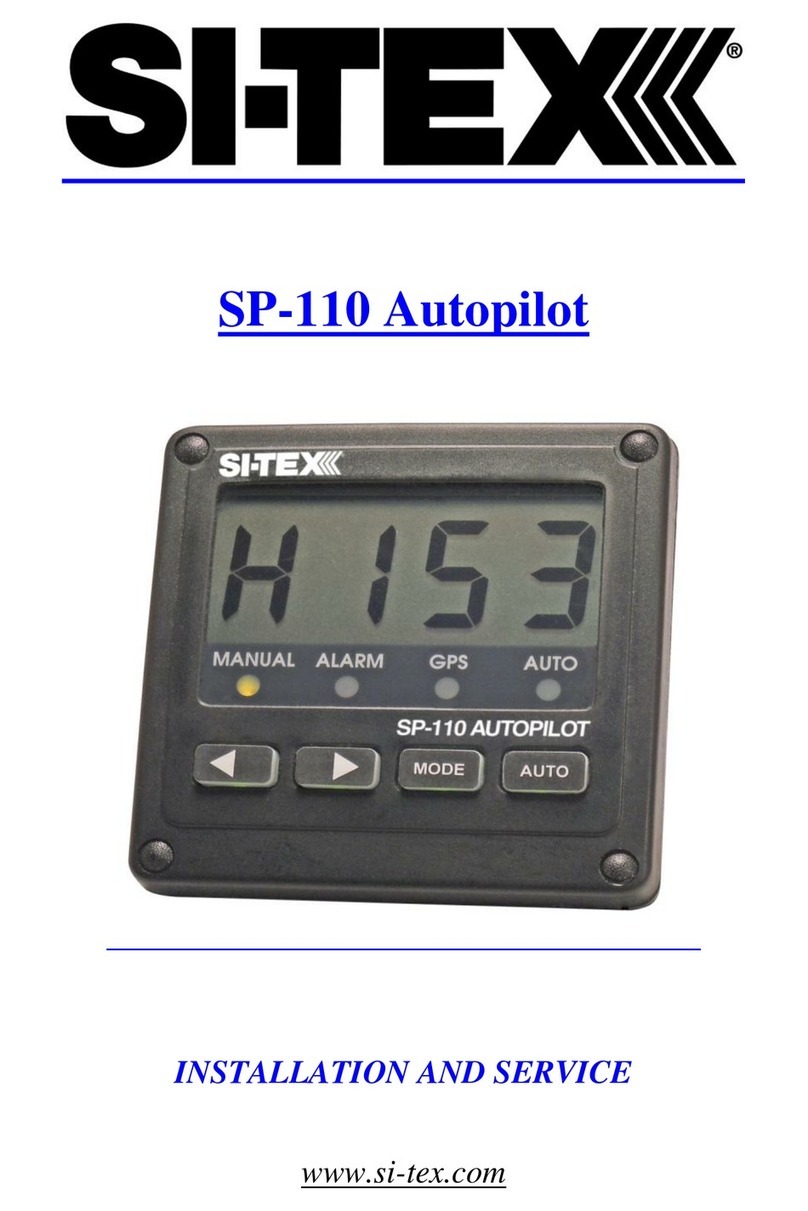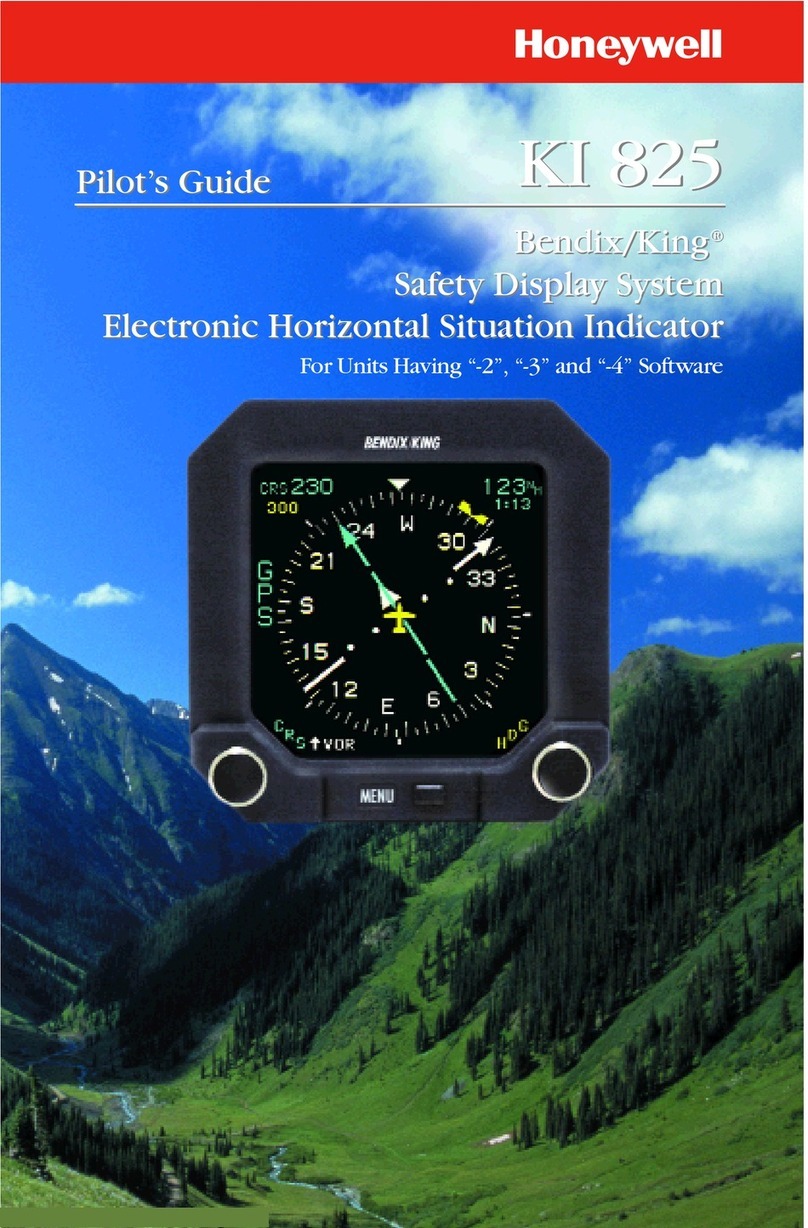Stec System 55X Owner's manual

P/N 13772-108 1 of 24
Cirrus Design Section 9
SR22 Supplements
Pilot’s Operating Handbook and
FAA Approved Airplane Flight Manual
Supplement
For
S-Tec System 55X Autopilot w/
Altitude Selector/Alerter
When the S-Tec System Fifty Five X (55X) Autopilot with Altitude
Selector / Alerter is installed in the Cirrus Design SR22, this
Supplement is applicable and must be inserted in the Supplements
Section (Section 9) of the Cirrus Design SR22 Pilot's Operating
Handbook. This document must be carried in the airplane at all times.
Information in this supplement adds to, supersedes, or deletes
information in the basic SR22 Pilot's Operating Handbook.
• Note •
This POH Supplement Revision dated Revision 5: 08-15-07,
supersedes and replaces Revision 4 of this supplement dated
07-18-05.
Revision 5: 08-15-07

2 of 24 P/N 13772-108
Section 9 Cirrus Design
Supplements SR22
Section 1 - General
This airplane is equipped with an S-TEC System 55X Autopilot. The
System 55X autopilot is a two-axis autopilot system. The system
consists of a flight guidance programmer/computer, altitude encoder,
altitude selector / alerter, turn coordinator, and HSI. Mode selection
and vertical speed selection is made on the programmer/computer
panel. A button on each control yoke handle may be used to
disengage the autopilot. The autopilot makes roll changes through the
aileron trim motor and spring cartridge and makes pitch changes for
altitude hold through the elevator trim motor. The SR22 installation of
the S-Tec System 55X Autopilot features:
• Heading Hold and Command;
• NAV/LOC/GPS/GS tracking, high and low sensitivity, and
automatic 45° course intercept;
• GPS Steering (GPSS);
• Altitude Pre-select, Hold and Command, Altitude display, and
baro correction;
• Altitude and Decision Height (DH) alert; and
• Vertical Speed Hold and Command.
Refer to S-Tec System Fifty-Five X Autopilot Pilot’s Operating
Handbook (POH) Serials 0002 thru 0434; P/N 87109 dated 8
November 2000 or later OR Serials 0435 and subsequent; P/N 87247
original release or later, for full operational procedures and description
of implemented modes. The System 55X POH also contains detailed
procedures for accomplishing GPS & VOR course tracking, front
course and back course localizer approaches, and glideslope tracking.
Refer to S-Tec Altitude Selector / Alerter Pilot’s Operating Handbook
(POH) P/N 8716 or P/N 87110 (original issue or later) for full
operational procedures and detailed description of operational modes
of the Altitude Selector / Alerter.
• Note •
The SR22 implementation of the System 55X Autopilot does
not utilize the optional remote annunciator, roll servo, and
optional trim servo. Therefore, all references to these items in
the S-Tec System 55X POH shall be disregarded. Additionally,
Revision 5: 08-15-07

P/N 13772-108 3 of 24
Cirrus Design Section 9
SR22 Supplements
this installation does not utilize a CWS (Control Wheel
Steering) switch or an AUTOPILOT MASTER switch.
• Note •
This installation utilizes the airplane’s roll trim actuator to
affect steering changes. Therefore, the automatic trim function
of the System 55X is not implemented. Disregard all
references in the S-Tec System 55X POH to this feature.
Roll information is displayed on the HSI. Autopilot Flight
Director is not implemented in this installation.
Section 2 - Limitations
1. Autopilot operation is prohibited above 185 KIAS.
2. The autopilot must not be engaged for takeoff or landing.
3. The autopilot must be disengaged for missed approach, go-
around, and balked landing.
4. Flaps must be set to 50% for autopilot operation in Altitude Hold at
airspeeds below 95 KIAS.
5. Flap deflection is limited to 50% during autopilot operations.
6. The autopilot must be disconnected in moderate or severe
turbulence.
7. Minimum engage height for the autopilot is 400 ft AGL.
• WARNING •
Autopilot may not be able to maintain all selectable vertical
speeds. Selecting a vertical speed that exceeds the aircraft’s
available performance may cause the aircraft to stall.
8. Minimum speed with the autopilot engaged is 1.2Vsfor the given
configuration.
9. For VOR/GPS and ILS glideslope and localizer intercept, capture,
and tracking, the following limitations apply:
a. The autopilot must be disengaged no later than 100 feet below
the Minimum Descent Altitude.
Revision 5: 08-15-07

4 of 24 P/N 13772-108
Section 9 Cirrus Design
Supplements SR22
b. The autopilot must be disconnect during approach if course
deviation exceeds 50%. The approach should only be
continued by “hand-flying” the airplane.
c. The autopilot must be disengaged at the Decision Height.
d. 12 knot maximum crosswind component between the missed
approach point and outer marker.
e. The intercept of the localizer shall occur at least 5 miles
outside of the outer marker.
f. If the crosswind component is greater than 12 knots and less
than 17 knots, the intercept shall occur at least 10 miles
outside of the outer marker.
g. The intercept angle shall be no greater than a 45-degree
intercept.
h. The ILS is flown at normal approach speeds, and within any
STC or TC speed constraints and as defined in this flight
manual.
i. The flaps should be extended in the approach configuration
prior to the Outer Marker. No further changes in the flap
configuration should be made throughout the autopilot-
coupled approach.
j. The glideslope is approached in such a manner to allow
automatic arming of the glideslope, or if the glideslope is
manually armed no more than 15% above the glideslope.
10. The S-TEC System Fifty Five X Pilot’s Operating Handbook,
Serials 0002 thru 0434; P/N 87109 dated 8 November 2000 or
later OR Serials 0435 and subsequent; P/N 87247 original release
or later, must be carried in the airplane and available to the pilot
while in flight.
Revision 5: 08-15-07

P/N 13772-108 5 of 24
Cirrus Design Section 9
SR22 Supplements
SR22_FM09_1502A
Figure - 1
System 55X Altitude Selector/Alerter & Autopilot Computer
Revision 5: 08-15-07

6 of 24 P/N 13772-108
Section 9 Cirrus Design
Supplements SR22
Section 3 - Emergency Procedures
Autopilot Malfunction
Refer to Electric Trim/Autopilot Failure procedure in the SR22 POH. Do
not reengage the autopilot until the malfunction has been identified
and corrected. The autopilot may be disconnected by:
1. Pressing the A/P DISC/Trim switch on the control yoke handle.
2. Pulling the AUTOPILOT circuit breaker on Essential Bus.
Altitude lost during a roll or pitch axis autopilot malfunction and
recovery:
Flight Phase Bank Angle Altitude Loss
Climb 40° 200 ft
Cruise 45° 300 ft
Descent 40° 350 ft
Maneuvering 10° 60 ft
Approach 10° 80 ft
Revision 5: 08-15-07

P/N 13772-108 7 of 24
Cirrus Design Section 9
SR22 Supplements
System Failure and Caution Annunciations
If any of the following failure annunciations occur at low altitude or
during an actual instrument approach, disengage the autopilot,
execute a go-around or missed approach as appropriate. Inform ATC
of problem. Do not try to troubleshoot until a safe altitude and
maneuvering area are reached or a safe landing is completed.
Annunciation Condition Action
Flashing RDY for 5
seconds with
audible tone.
Autopilot disconnect. All
annunciations except RDY
are cleared.
None.
Flashing RDY with
audible tone then
goes out.
Turn coordinator gyro
speed low. Autopilot
disengages and cannot be
re-engaged.
Check power to turn
coordinator.
Flashing NAV,
REV, or APR.
Off navigation course by
50% needle deviation or
more.
Use HDG mode until
problem is identified.
Crosscheck raw NAV
data, compass heading,
and radio operation.
Flashing NAV,
REV, or APR with
steady FAIL
Invalid radio navigation
signal.
Check Nav radio for
proper reception. Use
HDG mode until problem
is corrected.
Flashing VS Excessive vertical speed
error over selected vertical
speed. Usually occurs in
climb.
Reduce VS command
and/or adjust power as
appropriate.
Flashing GS Off glideslope centerline by
50% needle deviation or
more.
Check attitude and
power. Adjust power as
appropriate.
Flashing GS with
steady FAIL
Invalid glideslope radio
navigation signal.
Disconnect autopilot and
initiate go-around or
missed approach
procedure. Inform ATC.
Flashing GS plus
ALT.
Manual glideslope disabled. Re-enable by pressing
NAV mode button.
Revision 5: 08-15-07

8 of 24 P/N 13772-108
Section 9 Cirrus Design
Supplements SR22
Section 4 - Normal Procedures
Refer to Section 7 – Systems Description for a description of the
autopilot and altitude selector and their respective modes.
The Autopilot is integrated with the Altitude Selector/Alerter and can
be operated with or without data inputs from the Altitude Selector/
Alerter. The autopilot ALT and VS modes are coupled to the Altitude
Selector/Alerter ALT and VS outputs by pressing and holding the
Autopilot Programmer/Computer VS button and then pressing the ALT
button. Altitude Selector Vertical Speed output can be individually
coupled to the autopilot through the autopilot VS mode by pressing the
autopilot VS button.
• WARNING •
The pilot must properly monitor and control the engine power
to avoid stalling the airplane in autopilot altitude hold or
vertical speed modes.
• Note •
Any coupled Altitude Selector / Alerter mode can be disabled
by disconnecting the autopilot.
Autopilot and Altitude Selector Pre-Flight Tests
1. Battery Master Switch ............................................................... ON
2. Transponder .............................................................................. ON
3. Avionics Power Switch .............................................................. ON
Note that all autopilot annunciators, except CWS, and TRIM
illuminate. After about 5 seconds, all lights will go out. When the
turn coordinator gyro has reached operational RPM, the RDY
annunciator will come on.
4. Altitude Selector Tests:
a. Altimeter ................................................... Set Field Elevation.
b. Self-Test – On power up, all annunciators come on for
approximately 5 seconds and then sounds an audio tone.
After the self-test is complete, press the DTA and then BAR
buttons on the altitude selector.
Revision 5: 08-15-07

P/N 13772-108 9 of 24
Cirrus Design Section 9
SR22 Supplements
c. Rotate altitude selector input knob to set BARO to the nearest
0.1 inch Hg.
d. Push ALT button to display ALT SEL. With a flashing SEL
annunciator, rotate the selector knob to input an altitude 300
to 400 feet lower or higher than the indicated altitude.
e. Push the VS button. Rotate the selector input knob to input the
desired climb (+) or descent (-) vertical speed.
f. Push ALT button, ALT SEL annunciator will illuminate.
g. Engage autopilot HDG mode.
h. Press and hold the VS button and then press the ALT button.
Autopilot VS and ALT annunciators will illuminate.
i. Rotate altitude selector knob to change selected altitude to
match field elevation. VS annunciator on autopilot
programmer should go out when the ALT SEL setting on the
altitude selector is within 100 feet of indicated altitude on
altimeter. Autopilot ALT mode should remain illuminated,
indicating autopilot altitude hold is engaged. If ALT
engagement does not occur within 100 feet of indicated
altitude, readjust BARO setting on altitude selector.
5. Autopilot Tests
a. Heading Mode .................................................................TEST
1.) Center the HDG bug under the lubber line on the HSI.
2.) Momentarily press HDG button on autopilot Mode
Selector. Note that HDG light illuminates.
3.) Then rotate HDG knob on the HSI to the left then right.
Note that control yokes follow movement of knob. Then
return HDG bug to lubber line.
b. Vertical Speed .................................................................TEST
1.) Press VS button on autopilot programmer/computer. Note
that VS light illuminates VS+0.
2.) Rotate the VS control knob to 500 FPM up (+5). After a
short delay, the control yoke will move aft.
3.) Rotate the VS control knob to 500 FPM down (-5). After a
short delay, the control yoke will move forward.
Revision 5: 08-15-07

10 of 24 P/N 13772-108
Section 9 Cirrus Design
Supplements SR22
c. Altitude Hold ....................................................................TEST
1.) Depress ALT button on autopilot programmer/computer.
Note that ALT annunciator comes on, VS annunciator
goes out, and yoke does not move.
d. Overpower Test:
1.) Grasp control yoke and input left aileron, right aileron,
nose up, and nose down to overpower autopilot.
Overpower action should be smooth in each direction with
no noise or jerky feel.
e. Radio Check:
1.) Turn on NAV1 radio, with a valid NAV signal, and select
VLOC for display on the HSI.
2.) Use autopilot programmer/computer to engage NAV
mode and move OBS so that VOR deviation needle
moves left or right. Note that control yokes follow direction
of needle movement.
f. Autopilot Disconnect Tests:
1.) Press Pilot A/P DISC/Trim Switch (control yoke). Note that
the autopilot disengages. Move control yoke to confirm
that pitch and roll control is free with no control restriction
or binding.
2.) Repeat step using Copilot A/P DISC/Trim Switch.
In-Flight Procedures
1. Autopilot RDY Light ...................................................... CHECK ON
2. Trim airplane for existing flight conditions.
3. Engage desired mode by pressing mode selector button on
autopilot programmer/computer.
Heading Mode
1. Begin by selecting a heading on HSI within 10° of the current
airplane heading.
2. Press HDG button on autopilot programmer/computer. The HDG
annunciator will illuminate and the airplane will turn to the selected
heading.
Revision 5: 08-15-07

P/N 13772-108 11 of 24
Cirrus Design Section 9
SR22 Supplements
3. Use HSI HDG bug to make heading changes as desired.
Autopilot Altitude Hold Mode
1. Manually fly the airplane to the desired altitude and level off.
• Note •
For smoothest transition to altitude hold, the airplane rate of
climb or descent should be less than 100 FPM when Altitude
Hold is selected.
2. Press HDG or NAV to engage a roll mode. The associated
annunciator will illuminate.
• Note •
A roll mode must be engaged prior to engaging a pitch mode.
3. Press the ALT button on the autopilot programmer/computer. The
ALT annunciator will illuminate indicating that the mode is
engaged and the autopilot will hold the present altitude.
• Note •
Manually flying the airplane off the selected altitude will not
disengage altitude hold and the autopilot will command a pitch
change to recapture the altitude when the control input is
released.
4. Altitude can be synchronized to another altitude by rotating the VS
knob on the programmer/computer. Clockwise rotation will
increase and counterclockwise rotation will decrease altitude 20
feet for each ‘click.’ The maximum adjustment is ±360 feet.
Adjustments greater than 360 feet can be made by selecting VS
mode and flying the airplane to the new altitude and then re-
engaging ALT mode.
Autopilot Vertical Speed Mode
1. Begin by manually establishing the desired vertical speed.
2. Press HDG or NAV to engage a roll mode. The associated
annunciator will illuminate.
• Note •
A roll mode must be engaged prior to engaging a pitch mode.
Revision 5: 08-15-07

12 of 24 P/N 13772-108
Section 9 Cirrus Design
Supplements SR22
3. Press the VS button on the autopilot programmer/computer to
engage the vertical speed mode. When the mode is engaged, the
autopilot will synchronize to and hold the vertical speed at the time
the mode was engaged.
• Note •
The vertical speed is displayed in 100-foot increments at the
far right of the programmer/computer window next to the VS
annunciation. A plus (+) value indicates climb and a negative
or minus (-) value indicates descent.
4. Vertical speed can be adjusted by rotating the VS knob on the
programmer/computer. Clockwise rotation increases and
counterclockwise rotation decreases rate of climb (or descent) 100
FPM for each ‘click.’ The maximum adjustment is ±1600 FPM.
• Note •
A flashing VS mode annunciator indicates excessive error
between actual vertical speed and the selected vertical speed
(usually in climb). The pilot should adjust power or reduce the
commanded vertical speed as appropriate to remove the
error.
Altitude Pre-Select
The altitude selector may be used to set up an altitude and vertical
speed for intercept and capture. The altitude can be above or below
the current altitude and the vertical speed chosen should be
appropriate (climb or descent) for the altitude. Once selected, the
altitude and vertical speed can be coupled to the autopilot by pressing
and holding the VS button and then pressing the ALT button.
1. Press altitude selector DTA button to enter the data entry (ENT)
mode.
2. Press altitude selector BARO button and adjust baro setting as
necessary.
3. Press the ALT button to enter altitude select mode. The SEL
annunciator will flash. Use the altitude selector knob to input the
desired altitude in thousands of feet; for example, 5500 feet is
entered as 5.5 and 10,500 is entered as 10.5.
Revision 5: 08-15-07

P/N 13772-108 13 of 24
Cirrus Design Section 9
SR22 Supplements
4. Press DTA again to accept altitude entry, the ENT annunciator will
go out and the SEL annunciator will stop flashing and illuminate
steady indicating that the system is in the ‘operate’ mode.
• Note •
When the system is in the ‘operate’ mode, pressing the ALT
button will cause the system to extinguish the SEL
annunciator and display the baro corrected encoded altitude.
Pressing the ALT button again will return the display to the
selected altitude and the SEL annunciator will come on again.
5. Press altitude selector VS button and use altitude selector knob to
input the desired vertical speed in 100 FPM increments. Turn the
knob clockwise to increase vertical speed and CCW to decrease
vertical speed. Positive (+) vertical speed indicates climb and
negative (-) vertical speeds indicates descent. Any vertical speed
from ±1 (100 FPM) to ±16 (1600 FPM) is selectable.
• Note •
If an altitude is selected that requires an opposite vertical
speed from that selected, the system will automatically select
the correct sign (‘+’ for climb, ‘-‘for descent) and a vertical
speed of 500 FPM.
6. After takeoff, press the VS button and then press and hold the ALT
button to engage the autopilot VS mode and arm the autopilot
altitude hold mode to capture and hold the selected altitude. If the
ALR button is pressed, the system will provide alarms at 1000 feet
and 300 feet from the selected altitude. As the airplane’s altitude
nears the selected altitude, the system automatically reduces
vertical speed command in 100 FPM increments to provide a 300
FPM vertical speed at altitude capture. The system will make a
smooth transition to the selected altitude and hold the selected
altitude.
Revision 5: 08-15-07

14 of 24 P/N 13772-108
Section 9 Cirrus Design
Supplements SR22
BARO Selection
Upon initial start-up, the altitude selector enters BARO select
immediately after the self-test if it is receiving a valid altitude signal.
The setting can easily be entered at this time. At other times, it is
necessary to select the DTA entry and BARO modes in order to adjust
the BARO setting. After initial start-up, the Baro setting can be
changed at any time using the following procedure:
1. Press DTA button on altitude selector to enter the data entry
mode. ENT will be annunciated.
2. Press BAR button to display the BARO setting. Repeated presses
of the BAR button will toggle the display between millibars and
inches Hg.
• Note •
The BARO setting can also be displayed by pressing the ALT
button while in the ‘operate mode’ (i.e. SEL annunciator
illuminated).
3. Rotate the selector knob (CW to increase setting or CCW to
decrease setting). Only three digits are displayed for millibars: for
a BARO setting of 952.8 mb, the display will indicate 952; and for a
BARO setting of 1003.8 mb, the display will read 003. For inches
Hg, the 1/100 decimal position will not be selectable or displayed;
for example, a 29.92 inch Hg setting is input and displayed as
29.9.
4. Press DTA again to accept the entry.
Set Decision Height (DH)
1. Press altitude selector DTA button to enter the data entry (ENT)
mode.
2. Press DH button to enter decision height with the display reading
0.0. Use the altitude selector knob to set the desired decision
height to the nearest 100 ft above the desired decision height. For
example, for a DH of 1160 feet, set 1200 feet.
3. Press altitude DTA button again to enter the selected DH. The
display will show the selected decision height for approximately 5
seconds and then revert to ALT mode and display the altitude. The
DH annunciator will remain illuminated indicating a decision height
Revision 5: 08-15-07

P/N 13772-108 15 of 24
Cirrus Design Section 9
SR22 Supplements
is set. As the airplane approaches within approximately 50 feet of
the decision height, the alert will sound and the DH light will flash.
As the airplane passes through approximately 50 feet beyond the
decision height, the alert will sound and the light will flash again.
• Note •
Pressing the DH button again will disable the DH function
causing the DH annunciation to go out. Repeated activation of
the DH button alternately activates and deactivates the DH
mode.
Set Altitude Alert (ALR)
1. Press altitude selector ALR button to arm alert mode. The ALR
annunciator will come on. Upon entering within 1000 feet of the
altitude selected in ALT SEL, the altitude alert chime will sound in
the cabin speaker and headphones and the ALR annunciator will
flash. The chime will sound and the ALR annunciator will flash
again as the airplane approaches within 300 feet of the selected
altitude. If the airplane’s altitude deviates ± 300 feet from the
selected altitude, the chime will sound and the ALR annunciator
will flash to indicate the condition.
2. To disable ALR, press the altitude selector ALR button again. The
ALR annunciator will go out.
GPS Tracking and GPS Approach
1. Begin with a reliable GPS signal selected on the NAV receiver.
2. Select desired course on HSI and establish a desired intercept
heading.
3. Press the NAV button on the autopilot programmer/computer
twice. The NAV and GPSS mode annunciators will illuminate.
• Note •
If the course needle is at full-scale deviation, the autopilot will
establish the airplane on a heading for a 45° intercept with the
selected course. As the airplane approaches the course, the
autopilot will smoothly shallow the intercept angle. The pilot
may select an intercept angle less than the standard 45° by
setting the desired intercept heading with the HSI HDG bug,
pressing and holding HDG, and then pressing NAV once to
Revision 5: 08-15-07

16 of 24 P/N 13772-108
Section 9 Cirrus Design
Supplements SR22
intercept course in NAV mode or twice to intercept course in
GPSS mode on the autopilot programmer/computer. When
the on-course intercept turn begins the HDG mode will
disengage and the annunciator will go out.
During the intercept sequence, the autopilot operates at
maximum gain and sensitivity (90% of standard rate turn).
When the selected course is intercepted, course deviation
needle centered, the course-tracking program is activated.
The system will remain at maximum sensitivity for
approximately 15 seconds while the wind correction angle is
established. The maximum turn rate is then reduced to 45%
standard rate. Approximately 60 seconds later, the maximum
turn rate is reduced to 15% standard rate.
4. For increased sensitivity during GPS approach or if desired for
enroute tracking, press the APR button on the autopilot
programmer/computer. The NAV, GPSS, and APR annunciators
will be illuminated. Use HDG to accomplish a procedure turn.
Engage GPSS again to complete the approach.
VOR Tracking and VOR-LOC Approach
1. Begin with a reliable VOR or VOR-LOC signal selected on the
NAV receiver.
2. Select desired course on HSI and establish a desired intercept
heading.
3. Press the NAV button on the autopilot programmer/computer. The
NAV mode will illuminate. Course interception and tracking will be
as described under GPS Tracking and GPS Approach above.
4. For station passage, set HDG bug to within 5° of selected course.
• Note •
If the HDG bug is within 5° of center and the course deviation
is less than 10%, the autopilot will immediately establish the
lowest level of sensitivity and limit the turn rate to a maximum
of 15% of a standard rate turn.
5. For increased sensitivity during approach or if desired for enroute
tracking, press the APR button on the autopilot programmer/
computer. Both NAV and APR annunciators will be illuminated.
Revision 5: 08-15-07

P/N 13772-108 17 of 24
Cirrus Design Section 9
SR22 Supplements
Glideslope Intercept and Tracking
1. Begin with a reliable ILS signal selected on the NAV receiver.
2. Select autopilot NAV and APR. Airplane must be within 50%
needle deviation of localizer centerline.
3. Select ALT mode. Airplane must be 60% or more below the
glideslope centerline during the approach to the intercept point. If
the above conditions have existed for 10 seconds, GS mode will
arm, the GS annunciator will come on and the ALT annunciator will
remain illuminated. When glideslope intercept occurs, the ALT
annunciator will go out and the system will track the glideslope.
• Note •
If approach vectoring locates the airplane too near the
glideslope at the intercept point (usually the outer marker), the
GS mode can be manually armed by pressing the ALT button
once. Once capture is achieved, GS annunciator will come on
and ALT annunciator will go out.
Section 5 - Performance
There is no change to the airplane performance when the S-Tec
System 55X autopilot is installed.
Section 6 - Weight & Balance
There is no change to the airplane weight & balance when the S-Tec
System 55X autopilot is installed.
Section 7 - Systems Description
Autopilot
The airplane is equipped with an S-Tec System 55X two-axis
Automatic Flight Control System (Autopilot). The autopilot
programmer/computer is installed in the center console radio stack.
The autopilot roll axis uses an inclined gyro in the turn coordinator
case as the primary turn and roll rate sensor. In addition to the turn
coordinator instrument, the roll axis computer receives signals from
the HSI and the #1 NAV/GPS radio. The roll computer computes roll
steering commands for turns, radio intercepts, and tracking. Roll axis
Revision 5: 08-15-07

18 of 24 P/N 13772-108
Section 9 Cirrus Design
Supplements SR22
steering is accomplished by autopilot steering commands to the
aileron trim motor and spring cartridge.
The pitch computer receives altitude data from the altitude encoder
pressure transducer plumbed into the static system, an accelerometer,
and glideslope information from the HSI and #1 NAV radio. Pitch axis
command for altitude hold, vertical speed hold, and glideslope tracking
is accomplished by pitch computer commands to the autopilot pitch
servo.
The altitude selector provides altitude and vertical speed pre-select
capability for the autopilot. A pre-programmed altitude and vertical
speed can be input into the altitude selector/alerter and then coupled
to the autopilot. The autopilot will then follow the selected vertical
speed until the selected altitude is reached. Then the altitude selector
will signal the autopilot to hold the selected altitude. The altitude
selector/alerter receives uncorrected altitude data from the same
altitude encoder used by the transponder. In addition to the preselect
functions, the altitude selector provides altitude alert, decision height,
and altitude readout.
28 VDC for autopilot and altitude selector/alerter is supplied through
the 5-amp AUTOPILOT circuit breaker on the Essential Bus.
All Autopilot mode selection is performed by using the mode select
buttons and VS knob on the autopilot programmer/computer in the
center console. Annunciators in the programmer/computer display
window annunciate modes. Refer to Figure 1 for an illustration of the
programmer/computer.
RDY (Ready)– Illuminates when autopilot is ready for engagement.
When the airplane’s Battery Master switch is turned on and the rate
gyro RPM is correct, the RDY annunciator will come on indicating the
autopilot is ready for the functional check and operation. The autopilot
cannot be engaged unless the RDY light is illuminated.
Revision 5: 08-15-07

P/N 13772-108 19 of 24
Cirrus Design Section 9
SR22 Supplements
HDG (Heading) Mode – When HDG is selected, the autopilot will
engage the HDG mode, fly the airplane to, and hold the heading set on
the HSI. Subsequent heading changes are made using the HDG knob
on the HSI. For smoothest transition to HDG mode, it is recommended
that the airplane be aligned to within 10° of the selected heading
before engaging HDG. The HDG mode is also used in combination
with the NAV mode to set up a pilot selected intercept angle to a
course.
GPSS (GPS Steering) – Pressing NAV twice will cause the autopilot
to go to GPSS for smoother tracking and transitions. When GPSS is
selected, the autopilot can be switched between heading and GPSS
modes of operation. In the heading mode, the converter receives a
heading error signal from the heading bug on the Horizontal Situation
Indicator. GPSS converts this information and sends this heading error
directly to the autopilot.
In the GPSS mode, the converter receives ground speed and bank
angle digital signals that are calculated and converted to a
commanded turn rate. The turn rate is then scaled and converted to a
DC heading error signal that is compatible with the autopilot. The end
result is an autopilot that can be directly coupled to the roll steering
commands produced by the GPS Navigator, eliminating the need for
the pilot to make any further adjustments to the HSI course arrow.
REV (Reverse Course) – When REV is selected, the autopilot will
automatically execute high sensitivity gain for an approach where
tracking the front course outbound or tracking the back course inbound
is required. The APR and REV annunciators will illuminate when REV
is selected.
APR (Approach) – When APR is selected, the autopilot provides
increased sensitivity for VOR or GPS approaches. APR may also be
used to provide increased sensitivity for enroute course tracking.
Revision 5: 08-15-07

20 of 24 P/N 13772-108
Section 9 Cirrus Design
Supplements SR22
GS (Glideslope) – The autopilot GS function will capture and track an
ILS glideslope. To arm the GS function, the following conditions must
be met: (1) the NAV receiver must be tuned to the appropriate ILS
frequency; (2) The glideslope signal must be valid – no flag; (3) the
autopilot must be in NAV/APR/ALT modes; and (4) the airplane must
be 60% or more below the glideslope centerline during the approach
to the intercept point, and within 50% needle deviation of the localizer
centerline at the point of intercept – usually the outer marker. When
the above conditions have existed for 10 seconds, the GS annunciator
will illuminate indicating GS arming has occurred (ALT annunciator will
remain on). When the glideslope is intercepted and captured, the ALT
annunciator will go out.
ALT (Altitude Hold), Mode – When ALT is selected, the autopilot will
hold the altitude at the time the mode was selected. Altitude hold will
not engage if an autopilot roll mode is not engaged. Altitude correction
for enroute barometric pressure changes may be made by rotation of
the VS knob on the autopilot programmer/computer. Clockwise
rotation will increase and counterclockwise rotation will decrease
altitude 20 feet for each ‘click.’ The maximum adjustment is ±360 feet.
Adjustments greater than 360 feet can be made by selecting VS mode
and flying the airplane to the new altitude and then re-engaging ALT
mode.
VS (Vertical Speed) Mode – When VS is selected, the autopilot will
synchronize to and hold the vertical speed at the time the mode was
selected. Altitude hold will not engage if an autopilot roll mode is not
engaged. The vertical speed is displayed in 100-foot increments at the
far right of the programmer/computer window next to the VS
annunciation. A plus (+) value indicates climb and a negative or minus
(-) value indicates descent. Vertical speed can be adjusted by rotating
the VS knob on the programmer/computer. Clockwise rotation
increases and counterclockwise rotation decreases rate of climb (or
descent) 100 FPM for each ‘click.’ The maximum adjustment is ±1600
FPM.
Revision 5: 08-15-07
Other manuals for System 55X
1
Table of contents
Other Stec Autopilot System manuals
Popular Autopilot System manuals by other brands
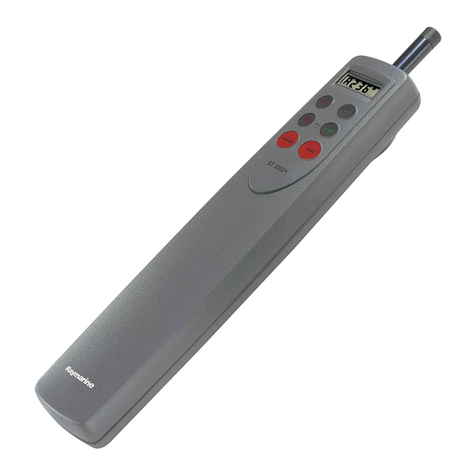
Raymarine
Raymarine ST1000+ Quick reference guide
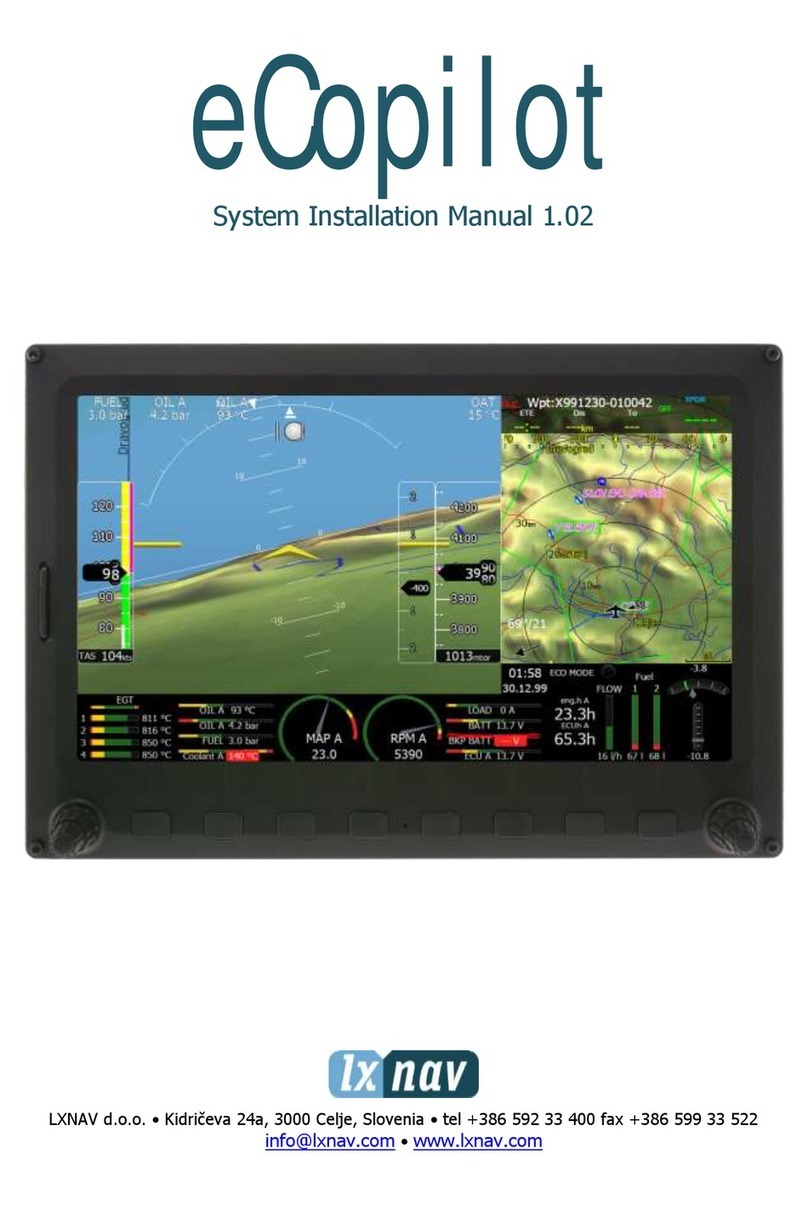
LXNAV
LXNAV eCopilot10 System installation manual

Furuno
Furuno FAP-330 Short form instructions
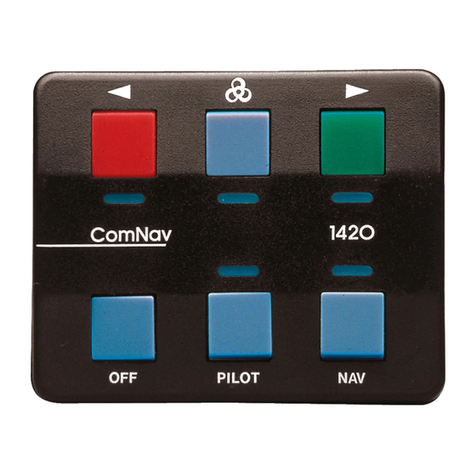
ComNav
ComNav 1420 Installation & operation manual
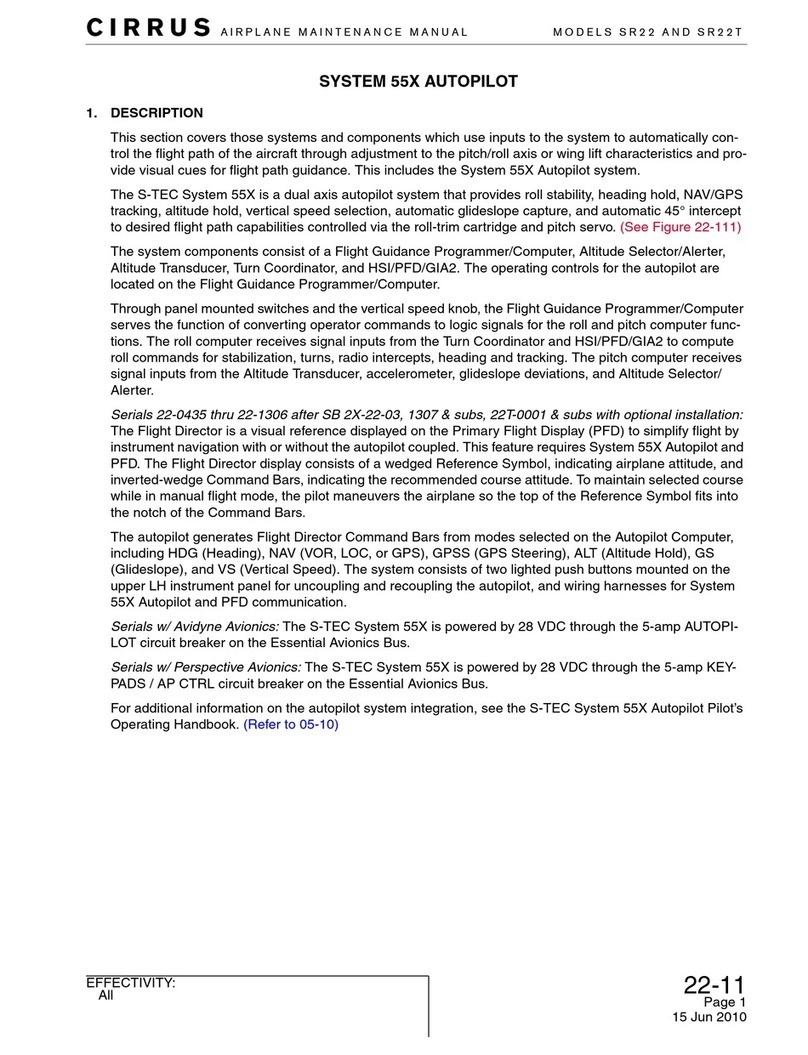
Cirrus
Cirrus System 55X Autopilot Airplane Maintenance Manual
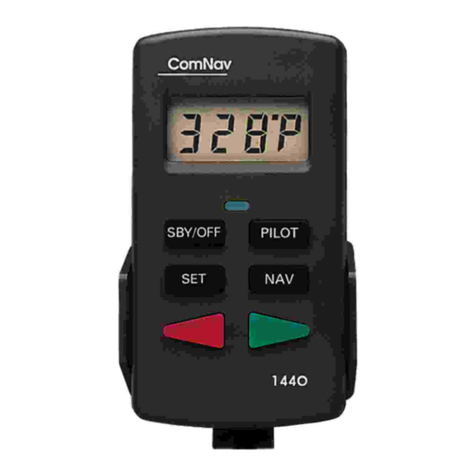
ComNav
ComNav 1440 Installation and operation manual
